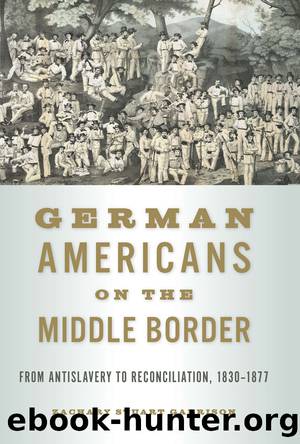German Americans on the Middle Border by Garrison Zachary Stuart;

Author:Garrison, Zachary Stuart; [Garrison, Zachary Stuart]
Language: eng
Format: epub
Publisher: Southern Illinois University Press
CHAPTER 6
REBEL BUSHWHACKERS AND THE âDAMNED DUTCHâ
RADICAL GERMANS AND THE DEEPER ROOTS OF MISSOURIâS GUERRILLA WAR
By summer 1863, Sam Hildebrand was perhaps the most notorious guerrilla fighter in southeastern Missouri. The Perryville Union suggested, âIt would be an exceedingly good thing if this rascal could be caught and hung. No man deserves it more.â For the warâs duration, his name appeared regularly in military reports and newspaper accounts deploring the spiraling violence. Although those loyal to the Union had much to fear, Hildebrandâs wrath seemed curiously concentrated on one segment of the population: German immigrants, or the âDutch,â âDamned Dutch,â or âBlack Dutch,â as Hildebrand and other noted guerrillas and native-born white people derisively referred to them.1
Indeed, throughout his colorful postwar memoir, Hildebrand often revealed his pointed enmity for Germans. In one instance, in August 1863, he and a small band of riders set out for the town of Hamburg, hoping to âtake in three or four Dutchmen who had given the relatives of my two men a great deal of trouble.â Deceptively donning the Union blue, Hildebrand coaxed one German to abandon his initial fear and leave the protection of his home. On realizing the grave error, âthe whole family came out, placed themselves in a group near us and implored in broken English to spare their father.â Despite the pleas, Hildebrand took the man a short distance away and âhung him to a lean tree.â In justification, Hildebrand cited a number of instances in which he believed Germans had victimized his own family, a fact compounded by the realization that âduring the whole war the Dutch went further, tried harder and risked more for my capture than any other people.â For Hildebrand, his family and his culture were under attack, suffering at the hands of immigrant outsiders.2
Consistent with traditional interpretations of Missouriâs guerrilla war, Hildebrandâs actions fit a pattern of personalized, retributive violence that largely lacked broader meaning or ideology.3 Yet plumbing the depths of Missouriâs guerrilla war reveals a cultural, economic, and ideological conflict with roots stretching decades before 1861, including German immigrantsâ first arrival in Missouri. Throughout the sectional crisis, Germans elevated their criticisms, portraying slave labor as anathema to a free society. By forming a powerful voting bloc in St. Louis and several river counties, they threatened to alter the stateâs political dynamic and uproot its institutions. This emboldened political activism fed the perception that Germans represented Northern fanatic abolitionism and were a horde of foreign mercenaries armed by an oppressive federal government. Yet rarely is German liberalismâs radical antislavery ascendance factored into interpretations of Missouriâs guerrilla warfare.
In German liberalismâs vision of western progress, slavery was an ugly contradiction and a historical wrong that needed correction. Sectional politics and the threat that secession posed to the Union radicalized antislavery Germans along the Middle Border. This was especially true in Missouri, where they saw the chance to upend traditional powers on the state and local levels and open avenues to German leadership. Militarily, Germans made up
Download
This site does not store any files on its server. We only index and link to content provided by other sites. Please contact the content providers to delete copyright contents if any and email us, we'll remove relevant links or contents immediately.
The Vikings: Conquering England, France, and Ireland by Wernick Robert(79931)
Ali Pasha, Lion of Ioannina by Eugenia Russell & Eugenia Russell(40158)
The Conquerors (The Winning of America Series Book 3) by Eckert Allan W(37149)
The Vikings: Discoverers of a New World by Wernick Robert(36923)
Cecilia; Or, Memoirs of an Heiress — Volume 1 by Fanny Burney(32437)
Cecilia; Or, Memoirs of an Heiress — Volume 2 by Fanny Burney(31873)
Cecilia; Or, Memoirs of an Heiress — Volume 3 by Fanny Burney(31857)
Empire of the Sikhs by Patwant Singh(22977)
The Secret History by Donna Tartt(18852)
Hans Sturm: A Soldier's Odyssey on the Eastern Front by Gordon Williamson(18486)
Cat's cradle by Kurt Vonnegut(15189)
Pimp by Iceberg Slim(14397)
Sapiens: A Brief History of Humankind by Yuval Noah Harari(14254)
Talking to Strangers by Malcolm Gladwell(13227)
Norse Mythology by Gaiman Neil(13211)
Leonardo da Vinci by Walter Isaacson(13189)
4 3 2 1: A Novel by Paul Auster(12289)
Underground: A Human History of the Worlds Beneath Our Feet by Will Hunt(12026)
The Radium Girls by Kate Moore(11927)
